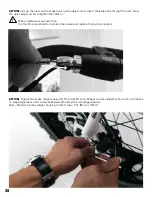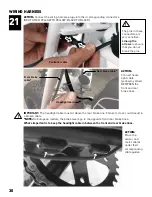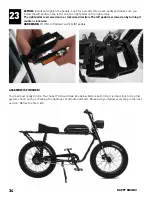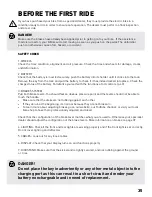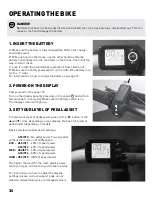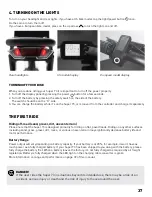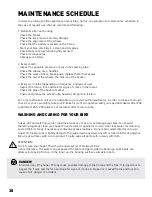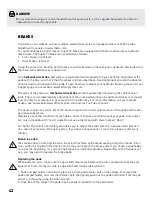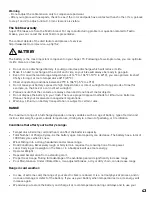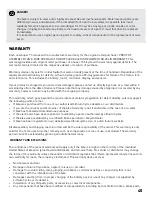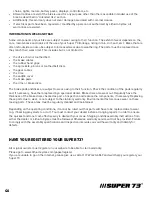
42
BRAKES
See video on our website on how to adjust: www.lithiumcycles.com/pages/owners or Tektro brake
adjustment manuals on www.tektro.com
For optimum braking performance, Super 73 bikes are equipped with Tektro mechanical or hydraulic
disc brakes. The Super 73 bikes are assembled as follows:
• Front brake = right lever
• Rear brake = left lever
Using the same disc, braking performance is similar between a mechanical or hydraulic disc brake, but
there are some differences in operation:
On a
hydraulic disc brake
, pad wear is compensated automatically. Simply check the alignment of the
pads with the disc, and check that the wheel is fully pushed back. Good alignment ensures the absence
of noise and a normal wear of the pads. To see how how to adjust your hydraulic brakes, please visit our
Support page on our website: www.lithiumcycles.com
The wear of the pads on a
mechanical disc brake
can be regulated by unscrewing the cable tension
knob. There is a complementary adjustment of the inner pad which can be tightened closer or removed
from the disc by screwing it in or out with a 5 mm Allen key. For more information on how to adjust
brakes, see our website www.lithiumcycles.com and our You Tube channel.
To ensure maximum service life of the brake components, avoid contamination of the pads and the disc
by greasy substances.
Regularly check the condition of your cables, ducts or harness and the wear of your pads. Some discs
are only compatible with “resin” pads. Do not use a metal pad with discs marked “Resin”.
For better ergonomics and safety, we advise you to adjust the brake levers in a position that places it
as a natural extension of the user’s arms. If you have any questions or concerns, please contact your
retailer.
Break-in period
Disc brakes have a 30-40 cycle break-in period to achieve optimal pad seating and performance. Exer-
cise caution for the first 30-40 cycles each time your replace the brake pads. If you notice a squeal-like
sound at the beginning, it’s normal. The brakes are naturally adjusting. Depending on the frequency of
use, you may need to replace the brake pads.
Replacing the pads
When pads are worn, make sure to adjust both clearances between the rotor and pad so that they are
equal to 0.3 mm. If only one side is adjusted it will cause braking failure.
1. Pads and pad holders are held in place by a 3 mm pad retainer bolt on the caliper. To remove the
pads and pad holder, unscrew the retainer bolt, then gently push out the pads and holder. This may be
easier to achieve by using the Allen wrench.
2. Once free of the caliper, the pads may be easily removed from the pad holder.
!
!
!
!
We recommend using our recommended brand of spare parts, or the original manufacturer parts for
replacement of used components.
DANGER!

